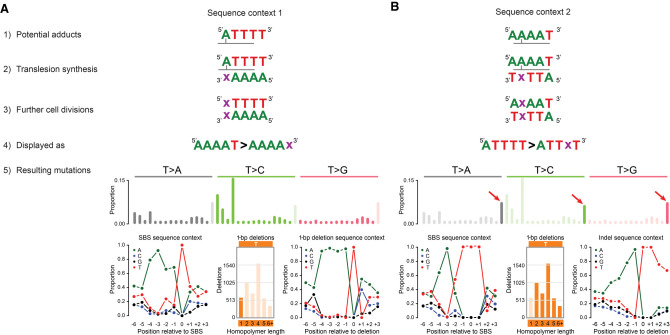Figure 6.
Proposed model for adduct formation leading to the mutation patterns of SBS_AnT and ID_AnT. (A) Potential adduct 1. (1) Adducts are formed on adenines directly 5′ of thymine homopolymers. (2) During translesion synthesis, an incorrect nucleotide (x) is incorporated opposite the adducted adenine. (3) During further cell divisions, the mutation is maintained. (4) Following the conventions of the mutational signature field, we display mutations as occurring from the pyrimidine of the Watson–Crick base pair. (5) Potential adduct 1 would lead to SBSs directly adjacent to TTT trinucleotides and deletions of single thymines not in thymine homopolymers. Both SBSs and deletions resulting from potential adduct 1 would be enriched for adenines up to 4 bp 5′ of the mutation site. (B) Potential adduct 2. (1) Adducts are formed in adenine homopolymers with a thymine directly 3′. (2) During translesion synthesis, an incorrect nucleotide (x) is incorporated opposite the adducted adenine. (3) During further cell divisions, the mutation is maintained. (4) Following the conventions of the mutational signature field, we display mutations as occurring from the pyrimidine of the Watson–Crick base pair. (5) Potential adduct 2 would lead to SBSs inside TTT trinucleotides and deletions of single thymines inside thymine homopolymers. SBSs resulting from potential adduct 2 would be strongly enriched for adenines 3 bp 5′ of the mutation site. Deletions resulting from potential adduct 2 would be strongly enriched for adenines up to 4 bp 5′ of the mutation site. The latter is owing to the possible different locations of the adduct inside the homopolymers. We believe that for longer homopolymers (more than three thymines), the adduct will nearly always be situated opposite the third thymine, making the −3 position (relative to the adduct) the −1 position relative to the thymine homopolymers. This explains the ∼100% presence of adenines directly 5′ of the thymine homopolymers.

